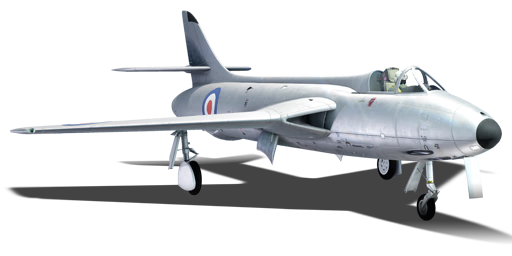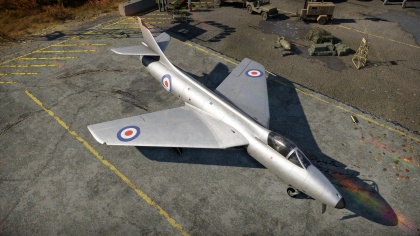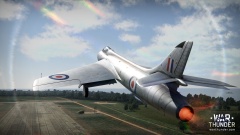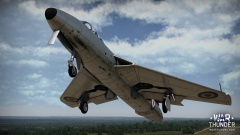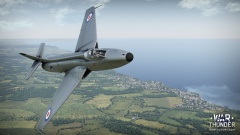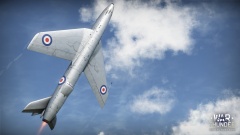Difference between revisions of "Hunter F.1"
m (Removed mention of BR in P&C due to fluidity.) |
m (→Pros and cons) |
||
| Line 207: | Line 207: | ||
* Horrible maneuverability | * Horrible maneuverability | ||
* May fight top-rank jets which out-class the Hunter in speed | * May fight top-rank jets which out-class the Hunter in speed | ||
| − | |||
== History == | == History == | ||
Revision as of 20:31, 25 February 2019
Contents
Description
The Hunter F.1 is a Rank British jet fighter
with a battle rating of (AB), (RB), and (SB). It was introduced in Update 1.53 "Firestorm".
The Hawker Hunter is the iconic 1950's British swept wing fighter. Produced from a requirement for a jet interceptor dating back to 1946 it fulfilled its role with outstanding success. Able to deliver a punishing blow with it's four 30 mm ADEN cannons and manoeuvrability at high speed, it sits as the top tier jet for the UK. The F.1 completes the current Hawker line in the British tree after the Vampire FB.1 and Venom FB.4, providing an initial steep learning curve. Its calling card is sheer speed, with the Hunter able to go supersonic in dives once spaded.
General info
Flight Performance
| Characteristics | |||||||
|---|---|---|---|---|---|---|---|
| Stock | |||||||
| Max Speed (km/h at 0 m - sea level) |
Max altitude (meters) |
Turn time (seconds) |
Rate of climb (meters/second) |
Take-off run (meters) | |||
| AB | RB | AB | RB | AB | RB | ||
| 1,098 | 1,092 | 14,000 | 32.0 | 33.3 | 44.6 | 40.7 | 820 |
| Upgraded | |||||||
| Max Speed (km/h at 0 m - sea level) |
Max altitude (meters) | Turn time (seconds) | Rate of climb (meters/second) |
Take-off run (meters) | |||
| AB | RB | AB | RB | AB | RB | ||
| ? | ? | 14,000 | ??.? | ??.? | ?.? | ?.? | 820 |
Details
| Features | ||||
|---|---|---|---|---|
| Combat flap | Take-off flap | Landing flap | Air brakes | Arrestor gear |
| ✓ | ✓ | ✓ | ✓ | X |
| Limits | ||||
|---|---|---|---|---|
| Wing-break speed (km/h) |
Gear limit (km/h) |
Combat flap (km/h) |
Max Static G | |
| + | - | |||
| 1,193 | 450 | 620 | ~11 | ~5 |
| Optimal velocities | |||
|---|---|---|---|
| Ailerons (km/h) |
Rudder (km/h) |
Elevators (km/h) |
Radiator (km/h) |
| < 850 | < 600 | < 650 | > 250 |
| Compressor (RB/SB) | ||
|---|---|---|
| Setting 1 | ||
| Optimal altitude | 100% Engine power | WEP Engine power |
| ?,??? m | ??? hp | ?,??? hp |
Survivability and armour
- 64 mm Bulletproof glass - Armored windscreen
- 12.7 mm Steel - Armor plate behind the pilot
Armaments
Offensive armament
The Hunter F.1 is armed with:
- 4 x 30 mm ADEN cannon, chin-mounted (150 rpg = 600 total)
Usage in battles
The Hunter is a 9.0 vehicle and its main strengths are high top speed and good guns, making it a good Boom & Zoomer.
The Hunter is less maneuverable than the F-86 and MiG-15 while being the second fastest with a good thrust-to-weight ratio. However the rate of climb is significantly worse than the other jets and so it requires some side climbing. Stay fast at all times and never drop beneath 850 TAS (~800 km/h in air).
The 30 mm ADEN cannon is an extremely powerful cannon. Being a revolver cannon, it fires extremely fast and has excellent ballistics. The Hunter F Mk.1 is, thanks to mounting a pack of four ADEN 30 mm cannons, the aircraft with the strongest burst mass, near 21 kg/s. This weapon's characteristics mean that 4 of them pose a serious threat for any aircraft that happens to be the target of them. The cannon, however, has the disadvantage of chewing very quickly through ammo thanks to its high rate of fire, so being wary of the ammo count is a necessity. The discrete tracer rounds may induce the player into error, causing the impression that only a light burst is being fired, however experience will quickly disprove anyone who thinks in this manner.
The armour-piercing rounds of the Hunter enable it to do some ground attack against light and medium tanks.
Modules
| Tier | Flight performance | Survivability | Weaponry | ||
|---|---|---|---|---|---|
| I | Fuselage Repair | Offensive 30 mm | |||
| II | New Boosters | Compressor | Airframe | ||
| III | Wings Repair | Engine | New 30 mm Cannons | ||
| IV | G-Suit | Cover | |||
Pros and cons
Pros:
- Highest acceleration in high speed zone (above 900 km/h)
- Easiest top jet for new players. Good guns, good speed, wings hard to rip.
- Large and effective air brake
- Insanely good armaments; four 30 mm ADEN cannons are the best in-game air combat weapons by far, shredding everything in a short-burst fire
- Very good energy retention
- Can out zoom climb MiG-17s and MiG-15bis
- Can out run any jet on your six if put into a 10° climb
- Armament is capable of destroying tanks and light pillboxes
- Boosters allow it to make deflection shots at high speeds
- 30 mm cannons have a high rate of fire altogether
Cons:
- Difficult to use against MiG-17s, mainly because they have better turn, climb rate and maneuverability
- Worst jet in terms of 1 vs 1 due to the bad maneuverability; you will be left in desperation when the rest of the team is gone
- Poor performance in horizontal turning
- Large target, especially when turning
- Horrible maneuverability
- May fight top-rank jets which out-class the Hunter in speed
History
In the aftermath of the second world war the Air Ministry issued Specification E.38/46 for a swept wing research aircraft that was fulfilled by a modified Hawker Sea Hawk (P.1052). The experimental aircraft showed an jump in high speed performance and as a result Hawker went forward to modify the second P.1052 into the P.1081. With a swept tail plane and the engine exhaust now located at the rear of the fuselage instead of the split exhaust further improving performance, it attracted the RAAF. The P.1081 gave Hawker useful information for the development of the Hunter.
In 1946 the Air Ministry issued Specification F.43/46 that was later added onto in 1948 by Specification F.3/48. This demanded a speed of 629 mph at 45,000 ft and a high rate of climb (as F.43/46 was for a jet powered interceptor), while carrying an armament of four 20 mm or two 30 mm cannons. Using what they had learnt from the P.1052 and P.1081 they produced the Prototype P.1067. The new prototype first flew with the Avon 103 engine in 1951 with a second powered by the Avon 107 in 1952.The Air Ministry ordered the Hunter into production in 1950 with the Avon 113 power plant. Thus the iconic Hawker Hunter was born.
The first production or pre-production F.1s entered service in 1953. The first was WT556 that entered service with A&AEE on the 16th of July 1953 and a further 15 delivered the same year. The Early F.1's featured boosted control surfaces but not the under belly air brake. The armament consisted of four 30 mm ADEN cannons with 150 rpg at 1200 rpm located under the nose. The Performance is documented like so:
Media
See also
Links to the articles on the War Thunder Wiki that you think will be useful for the reader, for example:
- reference to the series of the aircraft;
- links to approximate analogues of other nations and research trees.
External links
| Britain jet aircraft | |
|---|---|
| Blackburn | Buccaneer S.1 · Buccaneer S.2 · Buccaneer S.2B |
| British Aerospace | Harrier GR.7 · Sea Harrier FRS.1 (e) · Sea Harrier FRS.1 · Sea Harrier FA 2 |
| British Aircraft Corporation | Strikemaster Mk.88 |
| English Electric | Canberra B Mk 2 · Canberra B (I) Mk 6 · Lightning F.6 · Lightning F.53 |
| Gloster | Meteor F Mk 3 · Sea Meteor F Mk 3 · Meteor F Mk 4 G.41F · Meteor F Mk 4 G.41G · Meteor F Mk 8 G.41K · Meteor F Mk.8 Reaper |
| Javelin F.(A.W.) Mk.9 | |
| de Havilland | Vampire F.B.5 · Venom FB.4 · Sea Venom FAW 20 · Sea Vixen F.A.W. Mk.2 |
| Hawker | Sea Hawk FGA.6 · Hunter F.1 · Hunter F.6 · Hunter FGA.9 · Harrier GR.1 · Harrier GR.3 |
| Panavia | Tornado GR.1 · Tornado GR.4 · Tornado F.3 · Tornado F.3 Late |
| SEPECAT | Jaguar GR.1 · Jaguar GR.1A · Jaguar IS |
| Supermarine | Attacker FB 1 · Attacker FB.2 · Scimitar F Mk.1 · Swift F.1 · Swift F.7 |
| Foreign | Phantom FG.1 (USA) · Phantom FGR.2 (USA) · F-4J(UK) Phantom II (USA) |
| Australia | F-111C |
| India | ▄MiG-21 Bison |
| South Africa | ▄JAS39C |


